
by Jo Alex | One Light-Year (OLY) Road Trip Novel |
For the research of my novel, I contacted the Petrified National Forest to learn more about petrified wood. I got some good information but I really wanted to learn more about rocks and stones and crystals hands on.
A guided tour
Shortly after that call, a friend and I went to the Rice Northwest Museum of Rocks and Minerals in Oregon to learn about different rocks and stones. It seemed like when you actually start talking about rocks there is so much to learn. There is even a field call mineralogy which gets into the nitty-gritty.
We received a guided tour of what they housed in the museum. We talked about
Sedimentary rocks
Igneous rocks
Metamorphic rocks
We also held some discussion about quartz
The museum housed different types of quartz. Amethyst is a quartz crystal with a little iron impurity or impure perfections.
Thundereggs are “geode that got filled up…The crystals are made of the same stuff as amethyst, just a lot smaller.”
There were some cool looking ones.
Even interesting– was one rock from billions of years ago which blew my mind.
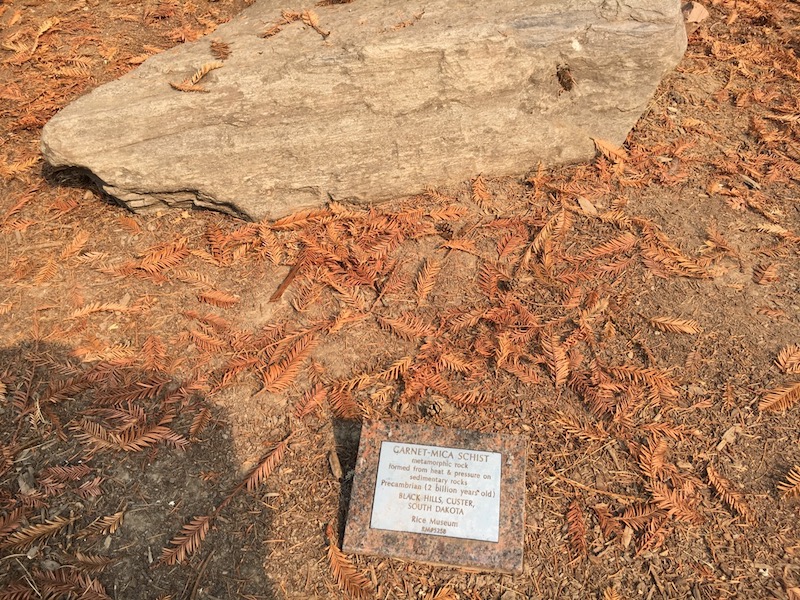
The tour took about ninety minutes that is because people had a bunch of questions. If you like rocks and museums, it is a good place to stop.

by Jo Alex | One Light-Year (OLY) Road Trip Novel, Travel in Washington |
We recently had a snowstorm here in the Northwest, and the grounds looked like a winter wonderland. I, for one, was glad it did snow because my characters in my novel play in the snow. And this snow storm gave me the opportunity to do firsthand research.
I read that the Eskimos have at least 100 words for snow. I can understand why they would have a hundred words for it. I don’t know what their words were, but let me give you a handful from my day in playing in the snow.
All the different types of snow
Playful snow
The snow that doesn’t stick to the ground
Pure white snow
The snow that sticks to the ground
Crystal cold snow
Powdery snow

Feeling the lightness of powdery snow
The snow that is light that I felt like I stepped inside a cloud
Crunch, crunch, crunch snow
Snow that is hard that I felt like it was gravel
Crisp snow
Snow that turns to slush when the rain falls
Cold numbing snow
Snow that doesn’t melt when the rain comes
Snow that that melts went the sun shines
Happy snow
Snow that makes bare trees look dressed up

Snow falling, winter wonderland
Snow that breaks twigs
Snow that keeps coming down
Snow that buries the chairs in the patio, making it disappear underneath the snow
Snow that makes ducks still swim like ducks
Snow that makes me want to build a snowman
Snow that makes me want to have snowball fight
Snow that makes me slide down the hill
Snow that makes me want to drink hot chocolate
Snow that makes warm memories
Snow that makes bring people outside
Snow that is quiet
Snow that is beautiful
Snow that is still magical
If you enjoyed this and want to see more pictures, please visit pictures posted on my Pinterest site.

by Jo Alex | One Light-Year (OLY) Road Trip Novel, Travel in Washington |
Living in the Pacific Northwest, I can tell you that almost eight months of the year it rains here. A rumor says that “the locals say that to drive away tourists.” That is funny. Alright, it doesn’t rain every single day for straight eight months, but about every week from October to June, there are drops and drops from the sky. Many days I don’t mind it at all. This year, we have had incredibly sunny days in October.
Now that I am almost finished with my novel one light year road trip, which would be a trilogy I wanted to reward myself with a new vista.
I took the opportunity to take a break to see Bellevue Botanical Garden. If you are a new visitor, Bellevue is a city across the water from Seattle. It sits east of Seattle. My friends had told me about the garden, but there are so many places in Western Washington to go to and places to go back to that I just saved it on my “later list.” It never occurred to me to go and visit until I started seeing the autumn trees changing. I couldn’t get enough of seeing the autumn colors, and I thought I would try out a new place.
The Northwest zen travel team, which would be the music man and the travel researcher took off to the garden to see what was unique about the garden.
In the Bellevue Botanical Garden
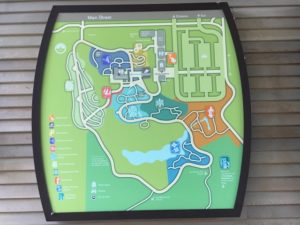
Map of the Bellevue Botanical Garden
The first part of the garden had beautiful blooms. Right next to the gift shop, delicate white flowers sprayed their scent in the air. It held the look of a white magnolia except the yellow was missing in the middle. The aroma gave off that of a mild Gardenia.
The garden used a numbering system for your self-guided tour. Usually, I could find names of flowers or plants stuck on the ground, but not here.
Instead, they had what they call scan and tap technology. I tapped my phone, and nothing scanned on my phone. I figured I needed an App. No posted sign as to which App.
Moving along to self-guided tour number three and four, I saw the same scanner. I couldn’t continue until I knew what some of the unique plants were. After I sought help, I downloaded the App called the QR Scanner.
After the installation of the App, I took the phone and scanned the funny lines on the post.
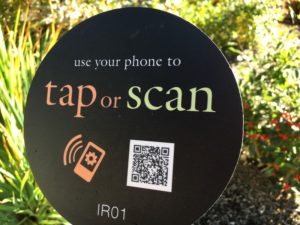
Tap and Scan needs QR App, visiting the Bellevue Botanical Garden
When the App read the code, a beep sound blasted, like you are at the checkout at the grocery store.
Immediately after the sound, my phone screen popped with a number of labeled images similar to the flower that I was viewing. Some of the images on the App appeared with similar pictures of the flowers in the garden which didn’t help me identify the flower.
This one plant with a red flower was called dinosaur food plant.
The layout of the garden
The landscape of the garden is divided into Spring Courtyard, Rock garden, Perineal Border, Waterwise garden, Yao garden, and many more. The walkaway composed of gravel, cement, and mini slopes.

Locations of the varied gardens
You will hear the city noises of cars passing by, but not enough to be distracted by it.
As we walked through the garden, more unique and colorful plants sprung its leaves, berries, or flowers. The garden didn’t house many tall trees, but they did have a few healthy pine trees nicely planted along the path. Right in the middle, they had a canopy of Bosnia maple in the Fuchsia Garden. It looked like those trees were trained to bend. The autumn leaves fell as soon a breeze blew Burning bushes framed the area nicely.
Down further a lantern stood which it made pretty to photograph. Passing through the doors were more trees.
My favorite part of the garden
A Tateuchi Viewing Pavillion was a nice touch in the Yao garden. Inspiration for the Yao Garden comes from both Japan and from Northwest plants to create form and function.

Bellevue Botanical Garden Tateuchi Viewing Pavillion
A small waterfall cascaded down multiple levels. Down the same path, we saw a pileated woodpecker doing what it does best. Near me on the ground was a squirrel exploring like us.

The pileated woodpecker
And then walking up the small path led us to my favorite scene. Bunch of orange and red maple leaves glowed under the sunset.
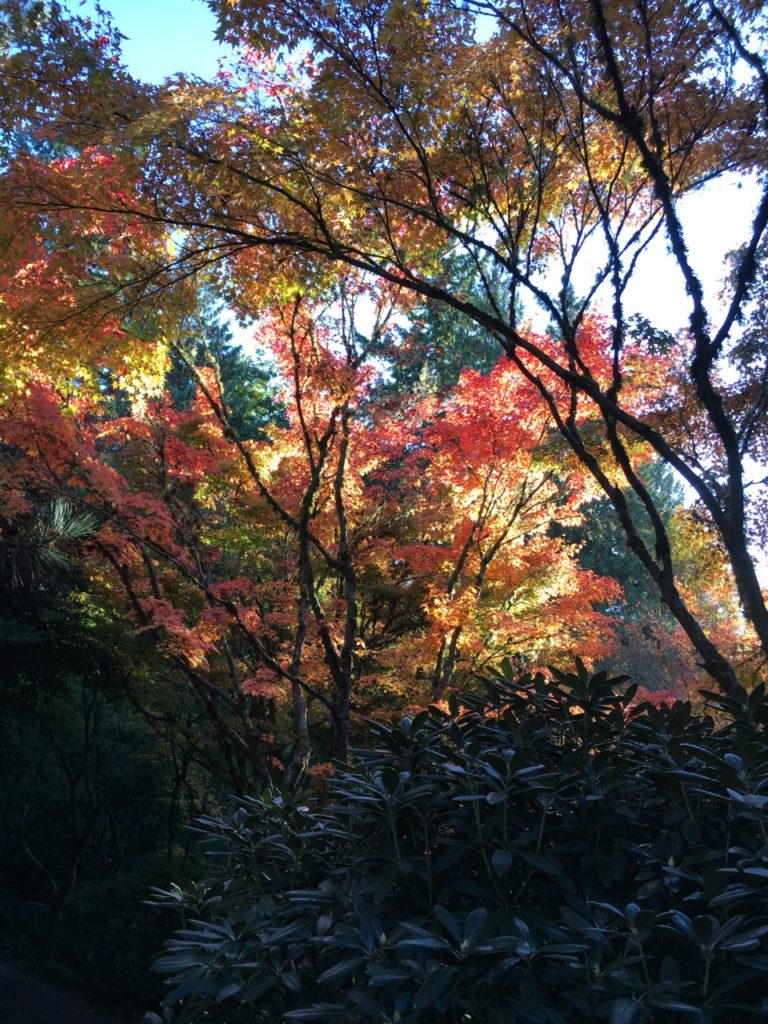
Maple trees basking the evening sun
People were carrying their professional cameras. There were a couple of people holding a reflector right at the turning leaf maple the garden.
We had to wait to walk through the path. The foliage turning is definitely a spot for testing out your camera.We walked to another part of the garden while they finished shooting pictures.
The music man said, “Look, we found a hobbit door.”
We knocked on the small door.
The music man was hoping that Bilbo Baggins would open the door.
The door remained shut tight. Sorry music man, he is on another adventure.

Is that a Hobbit house inside the Bellevue Botanical Garden?
We went back to the maple trees and shot a few pictures, until closing time. We covered most of the garden, except for a few areas.
Overall, the design of the garden provided a zen feeling. I would consider Bellevue Botanical Garden to be a great photography zone in the nearby Seattle area.
Tidbits:
They have tons of parking around the garden. There were only two spots left when we pulled up in our car.
Expect on sunny weekends; parking would be a problem, so schedule your trip, accordingly.
Admission to the garden is free. The garden has a donation slot.
I read on one of their posts that they decorate the garden for Christmas known as Garden d’ Lights, for that you would need to purchase tickets.
This is must do activity for locals and first-time visitors if you are in the Seattle/Bellevue area.
If you would like to see additional pictures and signs at the time of our visit:
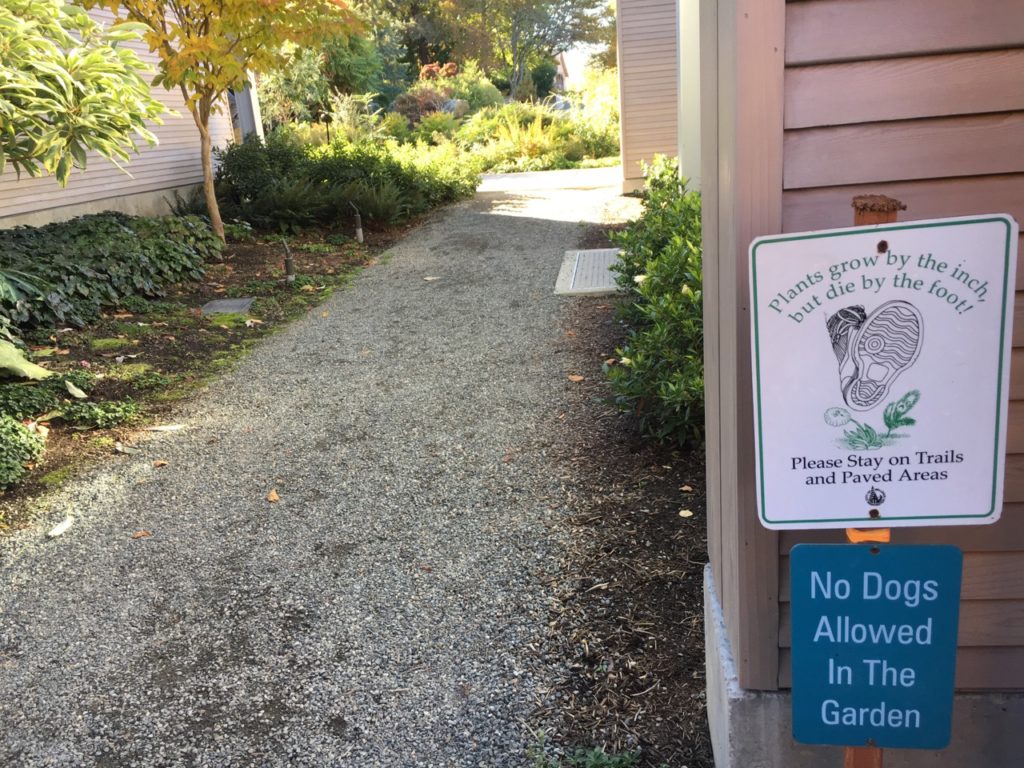
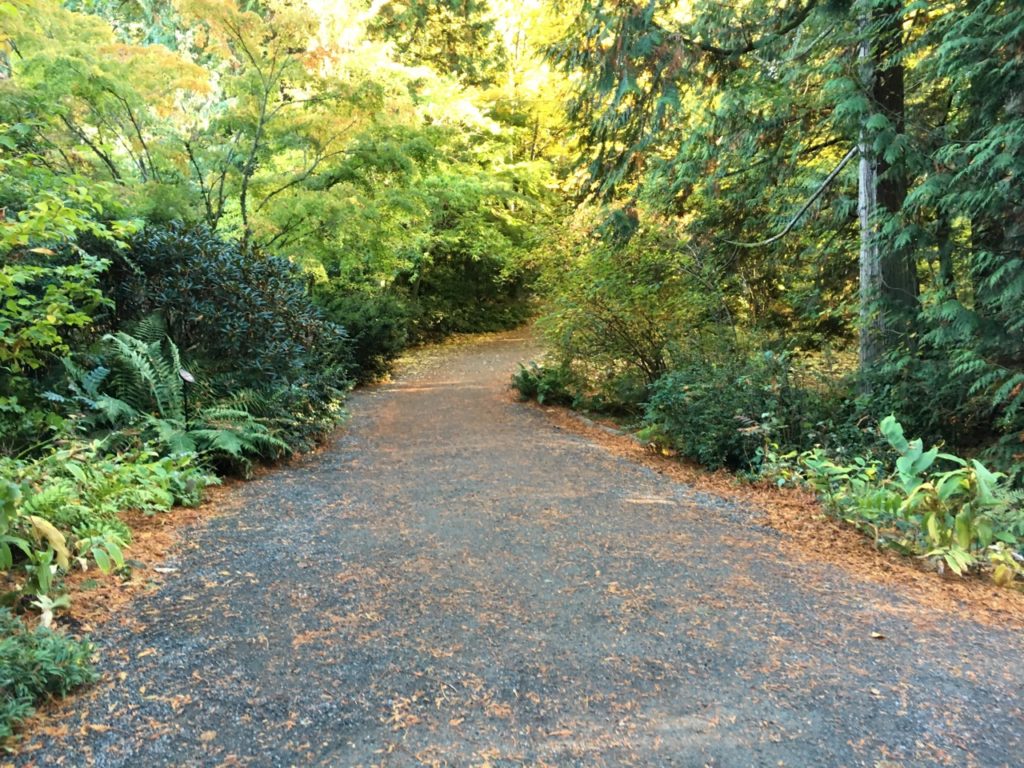
one of the trails in the garden
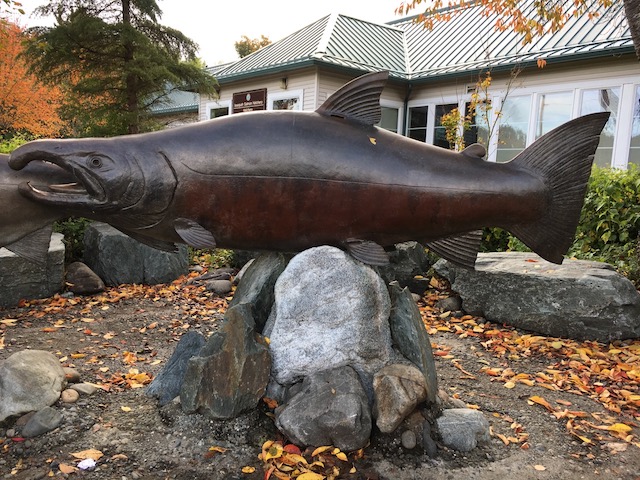
by Jo Alex | One Light-Year (OLY) Road Trip Novel, Travel in Washington |
Friends of the Issaquah Salmon Hatchery
I have always admired the epic journey of the Pacific salmon ever since I read about it as a teenager. I have eaten plenty of salmon, and I have learned about salmon throughout the years from both Seattleites and transplants, which gave me a deeper appreciation for them. Today Eric and I took a field trip to learn more about salmon spawning in the autumn at a salmon hatchery in Issaquah; known as Friends of the Issaquah Salmon Hatchery, also known as FISH.
A lot of useful information was provided on tour. This is what we learned from the Docent, the educator, who presented the tour.
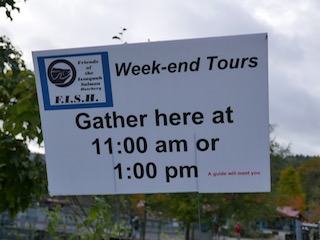
Tour hours for F.I.S.H Check their website for changes.
Main Points of the tour
The hatchery started in the 1930s to restore salmon to the river. At the time, the hatchery didn’t’ have any fish because it was decimated by logging, mining, and coal.
They got the salmon from another river.
In the 1970s, they were going to close the hatchery, because it was expensive to run it. However, the people of Issaquah volunteered to run it for free.
Now, volunteers do most of the work. If you like to volunteer, they are taking volunteers, now.
On our day of the visit, the water was muddy. Muddy water was filled with silt this year, which is very bad for salmon. The silt in the river covers the salmon eggs and suffocates the eggs. It is possible that few eggs if any will hatch, this year due to the silt flowing down the creek.

Issaquah Creek
The reason for the silt was because of the recent logging and development. The water no longer gets a chance to sink into the ground and instead flushes dirt into the river. There isn’t enough trees, grasses, bush or other vegetation on the surface to slow down the water to sink into the ground before entering the stream. Instead, it rushes over the surface and carries with dirt into the creek.
And the recent rain stirred up more silt.
It is hard for salmon to swim through the fish ladder when the water is muddy. The water irritates their eyes because they don’t have eyelids to protect them against the dirty water
A female salmon lays thousands of eggs. Most eggs will die, or predators will eat them. Ducks, kingfisher, raccoons herons (that must have been why we saw a heron hanging out on the roof, it smelled the salmon), and even other fish are all considered predators.
Of those eggs that reach maturity and swims to the ocean, only a few dozens make it back due to barriers and predators.
The hatchery let some of the salmon go upstream not all of them because the holding capacity of the river isn’t that great for all the salmon coming back.
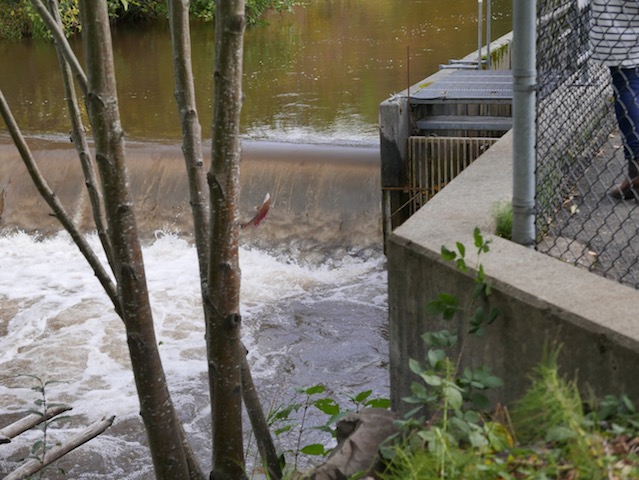
salmon trying to jump the weir
The hatchery fertilizes the salmon themselves.
Before salmon are released from the hatchery, their adipose fin is removed. This helps identify them as hatchery-raised fish. When a fisherman catches salmon, they are supposed to release any salmon that still have their adipose fin. This helps protect the wild salmon population. Removing the adipose fin does not affect the salmon’s ability to swim and is an easy way for them to mark the salmon as hatchery-raised.
They chop off all the tails of the dead salmon that they used to fertilize after they get the eggs, and throw the dead salmon without tails in the river. This is so that they can fertilize the river with the dead salmon bodies.
There were questions about fish farms and wild salmon from the audience.
There was not much talk about fish farms other than they are not helpful for the wild salmon.
One of the audience members brought up the recent release of Atlantic salmon around the Pacific Northwest.
The conversation continued that the Atlantic salmon is bad for the Pacific salmon gene pool. Atlantic Salmon should not be in the Pacific Northwest. Having Atlantic salmon fish farms threatens, the native wild salmon. If they mate, they produce sterile offsprings.
The government says that you are free to catch as many Atlantic salmon in the Pacific Northwest.
The wild Pacific salmon is at a threatening low number which raised another question
What can a regular consumer do to help protect salmon?
One of the ladies in the group said, call your congressperson to fight for environmental protection.
Tidbits: you can schedule a tour during the week. You are free to walk in during the weekends of the salmon spawning season, which is in autumn. Check their website for updated times.

Tour hours for F.I.S.H
FISH accepts a donation. There is a sign that says, “Feed Finley.”

Donation sign
Parking: we parked on the street.
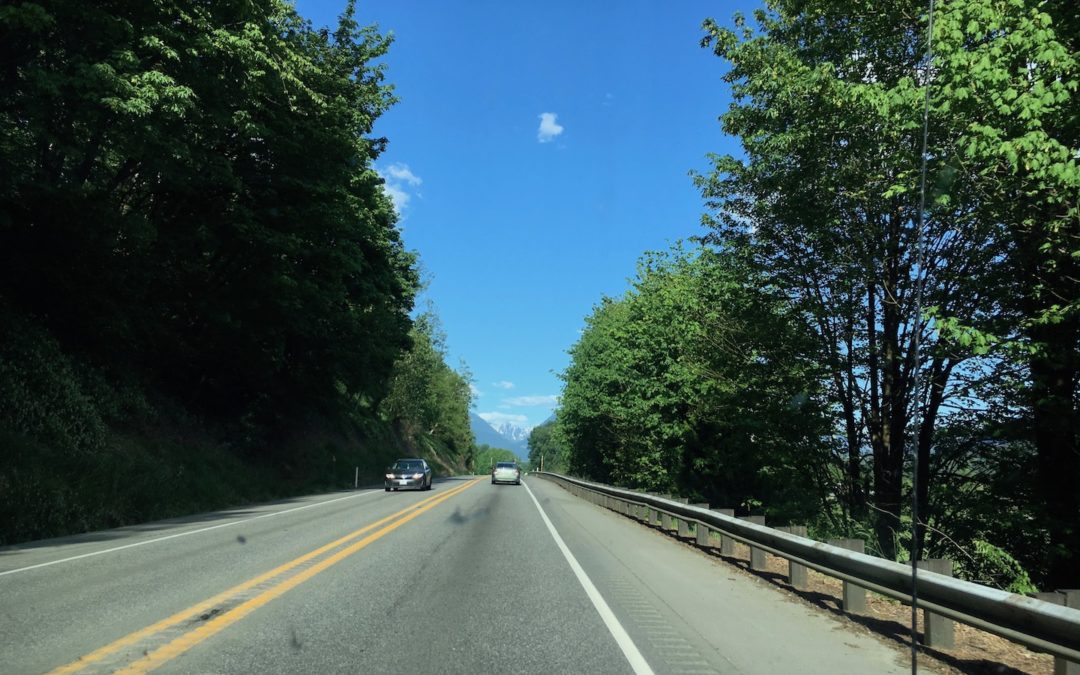
by Jo Alex | One Light-Year (OLY) Road Trip Novel |
I am writing a novel about road trip and more. My friend and I did a small road trip in autumn a while back ago and stayed in a cabin. We booked a cabin tucked away in the woods. We were happy to hear that the cabin was stocked with pots, plates, and a grill. All we had to do was bring our food and drinks which raised the question what to bring on a road trip? We decide to stop at the grocery store on the way up to the cabin and brought most of our food to cook. I love those kind of trips.
This road trip list below in no order but I noticed, cookies made it to the top of the list. I just added a few notes as I added this blog.
Road trip list: good, books and more
oatmeal and cranberry cookies
pancake mix
blue berries (to make blueberry pancakes)
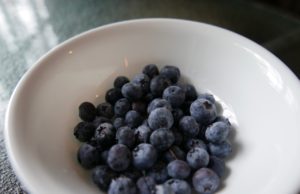
blueberries for pancakes
syrup
honey (I like a little bit of both on my pancakes).
eggs (it is good to have eggs with panckaes, yum).
milk
cheese
fruits in season (strawberries are in season)
fish (dinner)
potatoes (to be baked for dinner)
broccoli (I got have some vegetables, after all those cookies)
hot chocolate (if we don’t end up making the cake, that would be our dessert)
chips (snacks, need something cruchy, I should include apples, too)
peanut butter (in case if we decide to go for a long hike)
jelly (why you can’t have a peanut butter with out the jelly)
Bananas, just above ripe, not overly ripe. (bannas are just guewey good in the peanut butter sandwich).
bread
black beans
onion
lemon
olive oil
salt
pepper
garlic powder
cake? to bake or not (another tough decision)
Don’t forget
coffee beans (if you make your own coffee)
coffee grinder (if you are a coffee connisuer of sort)
bathing suit
lap top
my notes ( I like to write and then add some)
books to read ( I love to read about other people’s work, anything, really)
Rice cooker? ( I love rice, the rice cooker does a pretty decent job, though one of these days, I should make it on the stove top). Love the smell of Basmati rice.
fruit-strawberries (with blue berry panckaes, I like to see some red on the top or the side, sliced strawberries are always nice).
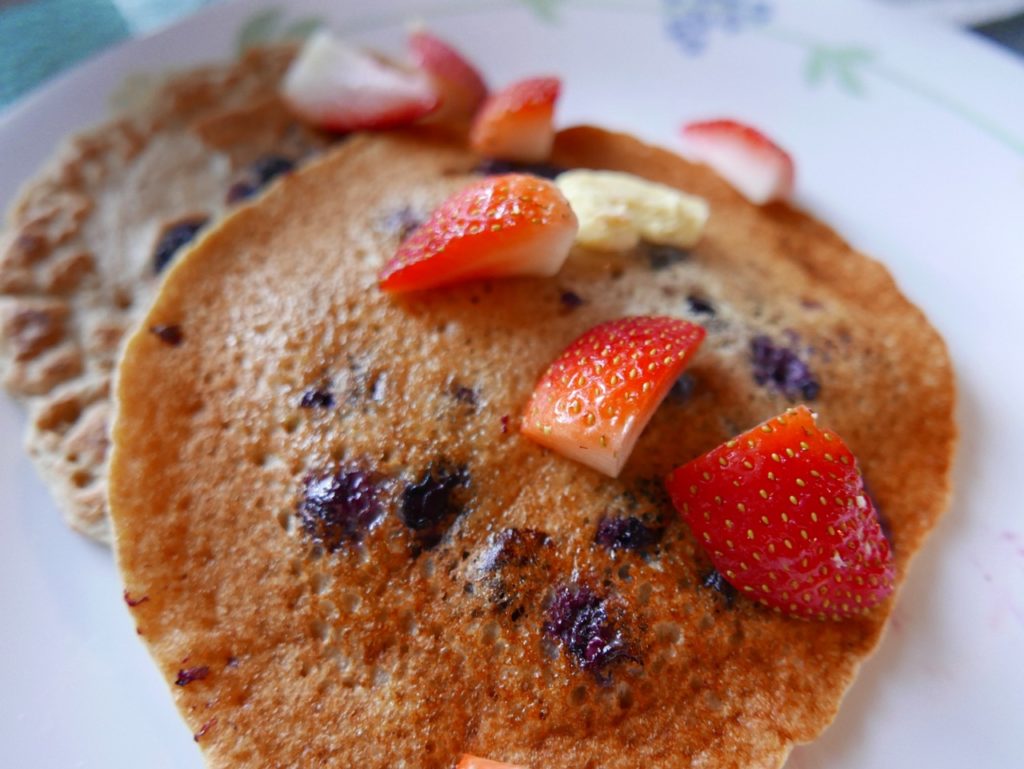
blueberry pancakes sprinkled wth sliced strawberries
orange juice (there is nothing like fresh squeezed juice with your breakfast pancakes). Now that I am adding this, I want to go make blueberry panckaes,eggs, syrup, and OJ for lunch. Instead, I will be having a second cup of coffee with grilled cheese. On my to make list, though.
soap
shampoo
extra bags for worn clothes
sandals
camera
toiletries and hygiene items
bath towels
kitchen towels
I am beginning to see the pattern here: food, books, lap top. Truthfully, it all depnds on what is important to you, especially the week or the weekend you are going?
What do you bring on a road trip?
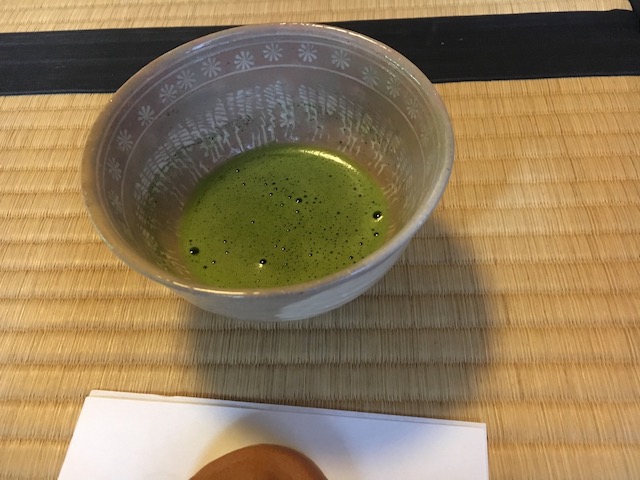
by Jo Alex | One Light-Year (OLY) Road Trip Novel |
If you are new in Seattle in autumn,and love to see fall colors going to the Seattle Japanese Garden would be a treat. I went to the Seattle Japanese garden to see the autumn colors and to participate in the tea ceremony. After my friend and I paid for admission to the garden and for the tea ceremony event, the man at the window asked if we liked to attend the free tour of the garden.
“Of course, would love to learn about the lovely garden,”
The garden tour
The Seattle Japanese garden covers 3.5 acres designed by Juki Lida. The designer made evert effort to have the garden look like what they see in Japan. The garden blends both “traditional Japanese plant materials and Pacific Northwest native plants,” to create good visual dynamic stroll. Strolling through garden, some sites are obvious and some needs to be pointed out by a tour guide such as the imaginary mountain with small cascading falls, cherry orchard (that is supposed to blossom) in the spring. Obvious landscape that struck: the pond. Inside the pond, Koi swims, happy to see visitors. Nestled in the west of the garden sits a humble tea house.
The tour guide told us the garden uses a ‘hide and reveal” effect. From the ticket booth, we started the tour. On the left was a beautiful Japanese maple tree, in the midst of turning colors. At that time of our visit, the leaves were a soft orange to a deep orange. The guide mentioned that they couldn’t guarantee when the leaves for going to change; however at the time of our visit, one third of the trees changed colors. A mix of maple trees, such as a Fullmoon Maple tree, a Dwarf Maple tree, and a Kotonito maple stood happy. The leaves of the Kotonito gets its name from skinny musical strings. The thin green leaves faded to slightly yellow.
Ferns, bamboos, and mondo grass seperates lowland and wetlands. The garden empasizes a Zen like feel with the placements of rocks, stones, lanterns, water, trees, shrubs and plants. To give spaces between leaves and trees, some of the trees in the garden were trained to move in the direction with a certain intention. The guide pointed out the Kobe lantern and the Kasuga lantern. Even the lanterns hold a purpose. The Kasuga lantern is a snow lantern and is meant to capture the snow on top of the lantern.
Seattle in autumn
It was a typical October day in Seattle. Out of towners bought an umbrella. Locals wore a solid rain jacket with a hood through the entire trip. I loved walking through the garden in the rain. I just wished I had a good cup of Seattle latte in my hand, even though we were going to drink green Matcha tea. Don’t get me wrong, I like tea on rainy days, too.
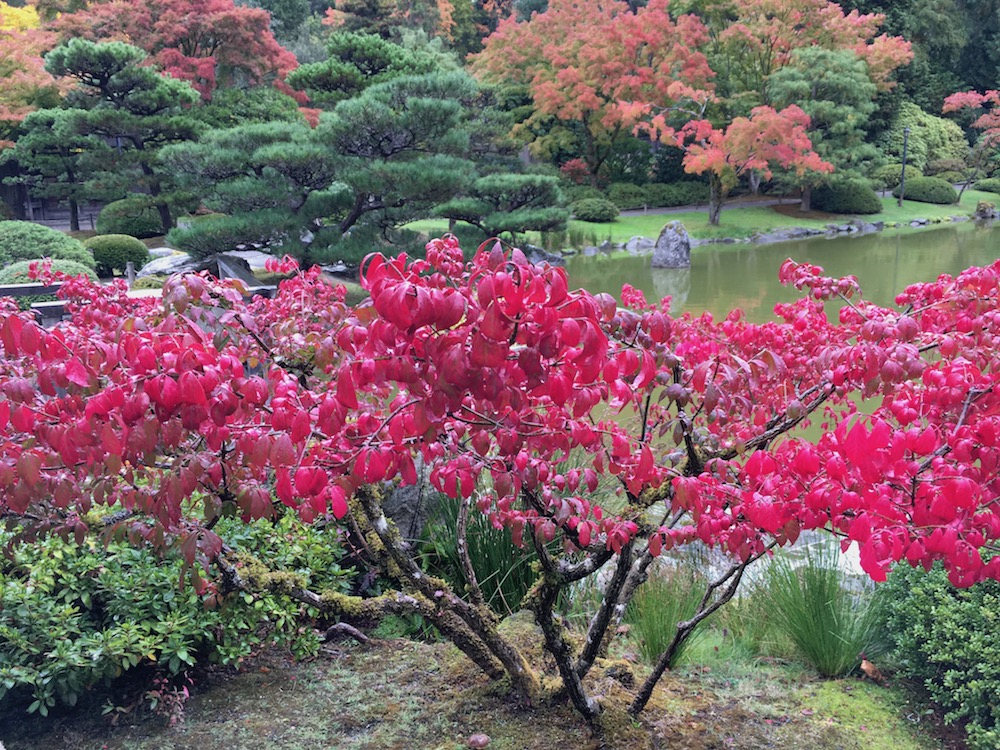
Burning Bush
On the bridge, we fed Koi, orange and silver and blue Koi opened their mouth eagerly. I dropped a few pallets of food in the water and the fish swam with their mouth open. They had big mouths but their eyes were not as sharp as the ducks. The mallards swam fast and pecked on the pallets I dropped. There are turtles that live in the pond. The guide said, they prefer to come out on sunny days. I dropped a few more pallets and the fish caught it.
The tour, cut short, as we neared the crimson red burning bush plant to go attend our tea ceremony.
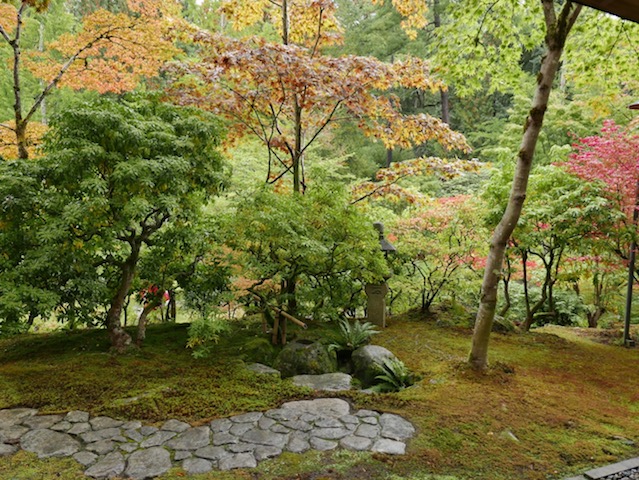
Seattle Japanese Garden in the autumn
The tea ceremony
The tea ceremony takes place only certain times of the year. Refer to the Seattle Japanese Garden website for event schedling. Schedule your tickets in advance, especially in the autmn season, as there is a limit how many can fit in the tea house.
Siutated in the garden, the tea house looked like a plain building from the outside. The door of the tea room slit open wth a simple large pot of tea and one decor hung from the wall. The minimilimistic simplicity was deliberate, to avoid distractions.
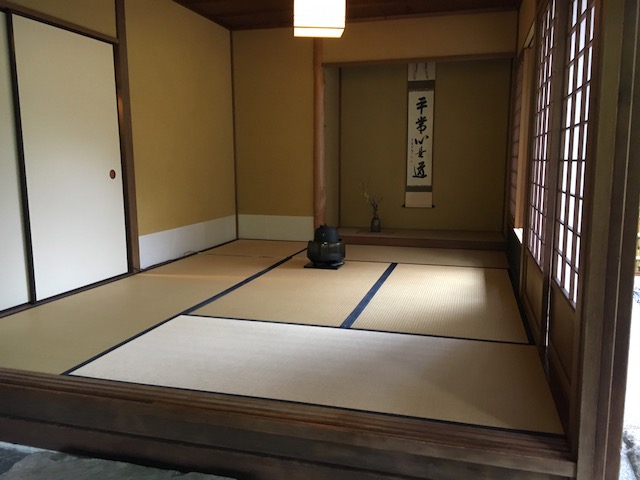
The tea room
First, the ceremony was more of a play then the audience participated in the ceremony in the end. Three ladies in the Kimono gowns and hosted the ceremony––one main speaker and two other ladies demonstrated the play.
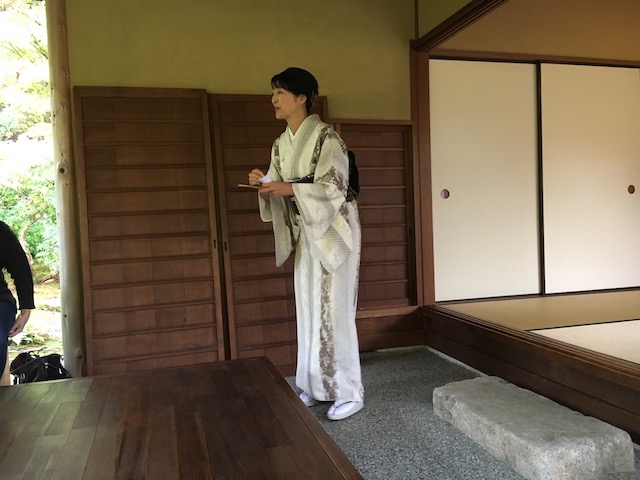
The Host
The speaker explained that decor hanging on the wall was more of a Japanese motivational poster. She translated the symbolic characters, “Today is an important day,” especially if you were a Japanese living back in the days of Samurais and civil wars because you didn’t know if you are going to live another day, especially back in the days of battle. The host didn’t elaborate more about Samurais and civil war back in those days, but emphasized come in and drink your tea and cherish today.
The main speaker explained that back in those days, only royalty got to drink teas. Commoners had to bow to royalty all the time. At some point in time, a small low door was constructed in the tea house so that nobles had to bent down too, when they entered. They couldn’t carry their swords in to the tea house.
After a little explanation of history and what to be expected from a host and a guest, which would be the guest would take off the shoes, the host will provide a clean, pretty bowl with tea and a friendly conversation, the lovely host poured the tea.
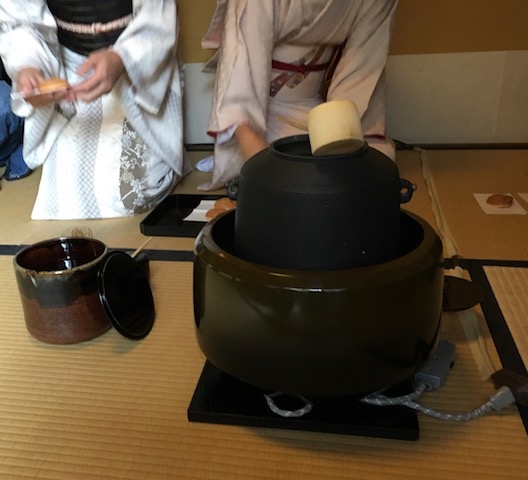
preparing green Matcha Tea
Tea house participation became a friendly ritual over the years. For our enactment, the host cleaned out the bowl, rinsing with hot water to make sure the tea bowl was clean. Then the host poured tea in to a rather mediums sized soup bowl with a laddle that I orndinarily would drink soup with. The guest in enactment takes the tea with both hands and bend to say thank you. The host bends in return as a your welcome.
I didn’t realize how many times the guest and the host bends as a form of respect. If i did that many bends a day, I would probably never have to exercise, again.
All three hosts respectfully served Matcha tea and a red paste biscuit from Kyoto for their audience. The inside bean paste was sweet, not overly sweet. The green Matcha tea was intentionally slightly bitter to enhance the drinking experience with the sweet biscuit. I thought they both went well together on a dark, rainy October day.
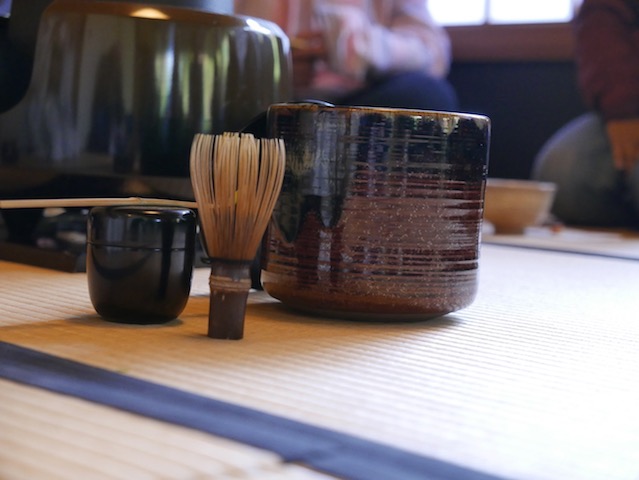
Tools used to prepare green Matcha tea
Some in the audience had questioned where to get the tea, I just drank it up. The tea comes in powder form and can be bought at your local Japanese store.
After that experience, I wish I had a tearoom in my home and a biscuit.

Matcha tea
If you are around, go and experience it for yourself.
Tid bits:
Wear socks because you will be taking off your shoes to walk on the tatami mat.
Parking: You can park right outside the front door of the Japanese Garden. Limited parking spaces.





























